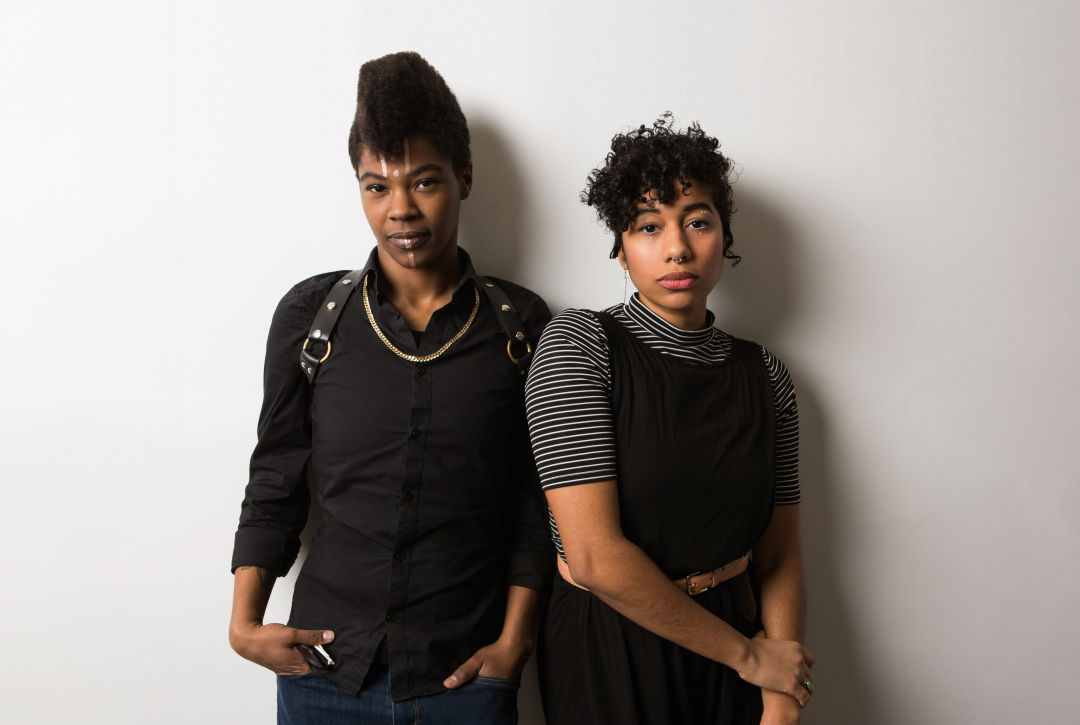A New North Portland Gallery Gives Space to Queer and Trans Artists of Color

Leila Haile (left) and Maya Vivas celebrate Ori Gallery’s grand opening on February 1.
Image: Christopher Dibble
Head north on Mississippi Avenue—past the microbrewery, the high-end shoe store, and the outdoor apparel boutique. Stop just before you get to the taxidermy art shop at an old wooden house, until recently home to an anarchist bookstore, before that enterprise left this highly prized strip of retail real estate.
This month, the building reopens as Ori Gallery, an art gallery and space for trans and queer artists of color and community organizing. It will be one of a small handful of black-helmed business on one of the main thoroughfares in what was once a largely African American neighborhood.
“It started off with a feeling,” says Maya Vivas, one half of the duo behind Ori, which takes its name from a Yoruba meditative practice. “I was going to art events, going to openings—and who is represented? Who is pushed to the forefront? I was not seeing myself or anyone who looks like me.”
Vivas cofounded Ori with tattoo artist and community activist Leila Haile, and recounts a pivotal moment at an art opening some years back. Vivas had work in the show, but was mistaken by one attendee for a member of the event’s waitstaff.
Now, with Ori, their goal is clear. “To hold institutional power,” Vivas says. “We’re running this.”
The space Haile and Vivas found tells its own story. A nonprofit based next door, Portland Collective Housing, owns the building, serving as both landlord and financial sponsor. The location, at the heart of a neighborhood once “redlined” via racist real estate practices, then transformed into a byword for gentrification, has a particular appeal to the Ori founders. “It feels even more intense to be in the space now that we just lost a predominantly black church up the hill,” says Haile. Originally from San Francisco, the 33-year-old has seen drastic changes in the neighborhood in their 13 years in Portland: “I was really, really sick of seeing so many storefronts on Mississippi with repurposed makers’ baubles and Edison bulb lamps and sticks with moss on them, selling for $15.”
Ori Gallery hopes to offer something different: a rotating gallery space, with a retail area up front for “artisans and people who make things that wouldn’t necessarily be considered fine arts.” The founders (both queer, and both of whom use "they/them" personal pronouns) also plan workshops—a POC-oriented figure drawing workshop is already scheduled—and events teaching people “creative ways to interact and disrupt.”
To make it happen, they’ve written grants feverishly—the project already bagged a $5,000 Precipice grant from PICA, among others—and raised $400 at a fundraising dinner at the end of last year. Since getting the keys to the building last July, the founders have been deep in improvements, adding a bathroom and a new ramp for disabled access.
This month’s inaugural exhibit, Elements of Reclamation, is co-curated by poet and artist Samiya Bashir and features five black artists—Lisa Jarrett, Sidony O’Neal, Intisar Abioto, Melanie Stevens, and Vivas—in a show that “encompasses place, culture, and community, past, present, and future.” Stevens, whose work in the exhibition comprises a series of screen prints and etchings about current events stitched together like a patchwork quilt, is excited at the advent of Ori.
“There is definitely a feeling of being ‘othered’ within the gallery space as a person of color and as an artist of color,” she says. “Even when you’re inside that world, there’s a feeling that you’re still being exoticized, or presented as some sort of diversity representation. Having this space run by artists of color is a huge opportunity for me to step out of that context and present my work as is.”
For Vivas, it’s about redefining “the white cube.” Even our current expectation that gallery walls be, well, white deserves questioning. “That concept of what is neutral and what is pure and what is blank and clean comes from Nazi ideologies,” Vivas notes, pointing out that white walls didn’t become a gallery staple until the 1930s.
Ori is opening its doors to all comers. “But my intention is that when people of color walk in here, they can see themselves reflected,” says Vivas. Already, the pair has fielded concerns about “limiting” those who can participate in Ori by focusing on queer and trans people of color. It doesn’t faze them. “All the other galleries have the illusion of equity, the illusion that anyone can be here, but they can’t,” says Vivas. “Not anyone can show up there, not anyone can see themselves reflected in that space. I’m looking to reflect the most marginalized identity, and the only difference is, we’re being explicit about it. When the day comes that our community feels like spaces like these are no longer needed, that’ll be great.”
Haile smiles. “That’s when we know our job is done.”




